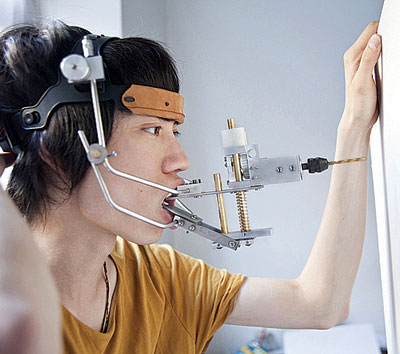|
Dates: Until June 16
Hours: 10 a.m.-5 p.m. (Monday-Friday), 10 a.m.-8 p.m. (Saturday-Sunday)
Venue: B10, North Area, OCT-LOFT, Nanshan District
Metro: Luobao Line, Qiaocheng East Station (侨城东站), Exit A

Cao Zhen
caozhen0806@126.com
THE “Design Can Change” International New Media Art Exhibition in OCT-LOFT is providing answers to some unusual questions — like whether it’s possible for non-experts to play music or to drill holes in a wall with your mouth.
The exhibition continues through June 16 and presents influential, interactive designs from across the world, providing visitors with new experiences and asking questions about how design can affect our lives and ways of thought.
The exhibition features creative designs provided by the Royal Academy of Arts in London; Queen Mary, University of London; Aalto University in Finland; Parsons The New School for Design, in the United States, and Hunan University in China.
In a project called “Polymetros,” visitors can play music as a group by clicking user interface panels. Created by Ben Bengler, a PhD candidate at Queen Mary’s School of Electronic Engineering and Computer Science, “Polymetros” is an interactive, collaborative music system that enables a group of people to improvise and compose music together on the fly. Every participant is provided with their own physical user interface, allowing for personalized musical contributions in a collaborative context.
“Music used to be a privilege for trained people only and my project is finding a way to make music a casual activity. It is designed for everyone to use and allows visitors to play music together as an enjoyable group activity,” Bengler told Shenzhen Daily at the exhibition’s May 12 opening.
In order to reach broader audiences, Bengler said, future exhibitions of “Polymetros” can be designed for festivals, museums and public workshops, or even mobile phone apps.
A similar project, “Mooski Masheen,” also is from a PhD candidate at Queen Mary. Dave Meckin’s project connects an acoustic guitar, a glockenspiel and a drum with digital systems on three iPads. Players can use the iPads to play the instruments. Meckin said “Mooski Masheen” is designed for people with disabilities or anyone seeking to have fun with music.
“Interactivity not only means computers and video signals playing off each other, but also — and more so — refers to communication among viewers and works,” He Renke, dean of Hunan University’s School of Design, said at the May 12 opening. “The trend of interactive design makes companies no longer focus on products themselves but more on human-centered experiences, holistic solutions and sustainable development.”
Another interesting project is “Mouth Factory,” a series of functional machines designed to be operated by the human mouth. Designed by Chinese graduate Guo Cheng of the Royal Academy of Arts in London, the tools include a chewing drill, a teeth lathe, a tongue extruder, a breath-powered rotational molding implement and a vacuum.
In a video at the exhibition, visitors can see Guo drilling holes in a wall and performing household chores through movements like chewing and blowing air. His actions are a testament to the wide range of tasks of which human bodies are capable.
In an earlier interview, Guo said he started the project by drawing a rough sketch and creating a two-dimensional spec sheet on a computer. He then took the design to a metal workshop to assemble the parts. He used basic tools such as a lathe, milling machine and wire saw.
“I’ve always been interested in human sensation, response and natural behavior. My work focuses on using your mouth to replace the functions of handicapped body parts, such as using your teeth to open a can, and behaviors like licking a wound or tearing out ingrown nails,” Guo said.
Unfortunately, visitors are not allowed to try the tools at the exhibition.
“The current ones are all customized to fit my body, so they are not suitable for other people to use. If I used 3D printing technology, that would render the device more precise and comfortable to wear. I would like to expand the oral apparatus to let more people experience the potential of mouth functionality,” Guo said.
English- and Chinese-language guides are available at the exhibition every afternoon.
|

